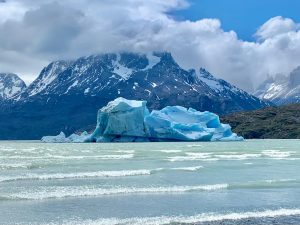
Esta imagen en la parte superior, representa un enorme glaciar desprendido en las costas de Chile. Son ya miles, los témpanos que flotan a la deriva en la laguna de San Rafael, que provienen del Campo de Hielo Norte, en la región austral de Aysén. Junto al Campo de Hielo Sur, forma la tercera masa de hielo más grande en el mundo, por detrás de la Antártida y Groenlandia.
Según Alexis Segovia, glaciólogo de la Dirección General de Aguas de Chile (DGA), este fenómeno ocurre también en casi la totalidad de los 26.000 glaciares del país y comenta:
“Los glaciares son un indicador por excelencia de cambio climático porque es hielo y reacciona a mayores temperaturas. Además, estas superficies devuelven mucha radiación de la que llega a la Tierra y si se siguen reduciendo el planeta se va a calentar más rápido”.
Ocurre lo mismo, cerca de Chile, en los glaciares de la Patagonia, los cuales han perdido 1.000 km2 de superficie en apenas 60 años.
Según los expertos en la materia, se estima que un tercio de los glaciares Patrimonio de la Humanidad no existirán en 2050. Además del aumento del nivel del mar -que puede equivaler a 60 metros respecto al nivel del mar actual-, existen otros riesgos como, por ejemplo, el cambio de temperatura del agua, provocando variaciones en el hábitat marino y afectando así, a la fauna que lo habitan. Por otro lado, estudios recientes de investigadores que trabajan específicamente en los diez glaciares del hemisferio norte -Alpes europeos, Groenlandia, Svalbard y Ártico Canadiense-, afirman que decenas de miles de microbios se desprenden con cada mililitro de agua; lo que podría significar que, en los próximos 80 años, más de cien mil toneladas de bacterias podrían ser expulsadas a las aguas de deshielo. Esta cifra podría ir en aumento o descender en función de si se logra mantener el calentamiento global por debajo de los 1.5 grados.
En definitiva, esta fotografía -pese a ser espectacular- cuenta mucho más de lo que se ve. Este tipo de imagen es un adelanto de un futuro que sí se encuentra en nuestras manos y que, como muchos expertos afirman, es complicado pensar que el cambio es reversible, pero nosotros, a través de nuestras acciones diarias, podemos ayudar a que la velocidad en la que se produce este cambio disminuya significativamente.
__
GLACIER MELTING
This image at the top represents a huge glacier detached off the coast of Chile. Thousands of ice floes are already floating adrift in the San Rafael lagoon from the Northern Ice Field in the southern region of Aysén. Together with the Southern Ice Field, it forms the third largest ice mass in the world, after Antarctica and Greenland.
According to Alexis Segovia, glaciologist at Chile’s General Water Directorate (DGA), this phenomenon also occurs in almost all of the country’s 26,000 glaciers and comments:
“Glaciers are an indicator par excellence of climate change because it is ice and reacts to higher temperatures. In addition, these surfaces return much of the radiation that reaches the Earth and if they continue to shrink, the planet will warm up faster. The same thing is happening near Chile, in the glaciers of Patagonia, which have lost 1,000 km2 of surface area in just 60 years.
According to experts in the field, it is estimated that one third of the World Heritage glaciers will no longer exist in 2050. In addition to the rise in sea level, which could be equivalent to 60 meters above the current sea level, there are other risks, such as, for example, the change in water temperature, causing variations in the marine habitat and thus affecting the fauna that inhabit it. On the other hand, recent studies by researchers working specifically on the ten glaciers of the northern hemisphere -European Alps, Greenland, Svalbard and Canadian Arctic-, state that tens of thousands of microbes are released with each milliliter of water; which could mean that, in the next 80 years, more than one hundred thousand tons of bacteria could be expelled into the melting waters. This figure could increase or decrease depending on whether global warming is kept below 1.5 degrees Celsius.
All in all, this photograph – despite being spectacular – tells much more than meets the eye. This type of image is a preview of a future that is in our hands and that, as many experts say, it is difficult to think that the change is reversible, but we, through our daily actions, can help to slow down the speed at which this change occurs significantly.
__

